New short brazilian malacological communication available ...!

NEW SHORT BRAZILIAN MALACOLOGICAL COMMUNICATION AVAILABLE
+ AGUDO-PADRÓN, A.I. 2012. Conservation situation of native land snails threatened by “actions for eradication” of exotic species in Brazil, South America. Biological Evidence, 2(1): 1-2. Available online at: https://bio.sophiapublisher.com/html-464-40-be
TRADUÇÃO LIVRE AO PORTUGUÊS
https://projetocaramujoafricano.blogspot.com.br/2012/09/um-argumento-cientifico-de-boa.html
https://smtpilimitado.com/kennel/caracol13.pdf
Florestal native snails Orthalicus cf. prototypus Pilsbry, 1899
(BULIMULIDAE)
captured “simultaneously” with African snails in semi-rural areas in Northeastern Brazil
Maurício Carneiro Aquino, Maceió/ AL, Brazil
https://noticias-malacologicas-am.webnode.pt/news/contraditorio-e-silencioso-consentimento-/
In the next "movie" a beautiful specimen of native florestal arboreal snail Orthalicus cf. pulchellus (Spix, 1827) (BULIMULIDAE) confused with exotic giant African snail Achatina (Lissachatina) fulica :

Photo: Brazilian Shell Club - CdB
https://globotv.globo.com/tv-sergipe/estacao-agricola/v/confira-as-dicas-para-evitar-e-combater-o-caramujo-gigante/2142320/
https://projetocaramujoafricano.blogspot.com.br/2012/10/sergipe-problema-serio-com-globo.html
EXTENSIVE CONTENTS
South American dangerous environmental controversy: combat to the invasive exotic snail Achatina fulica in wildlife v/s conservation of threatened native and endemic land snails
"Public campaigns misguided who seek to control/ eradicate the invasive giant african snail Achatina (Lissachatina) fulica in wildlife promotes the indiscriminate extinction of native snails"
by:
A. Ignacio Agudo-Padrón
Project “Avulsos Malacológicos”, Caixa Postal (P.O. Box) 010, 88010-970, Centro, Florianópolis, Santa Catarina, SC, Brasil
https://noticias-malacologicas-am.webnode.pt
INTRODUCTION
A serious and worrying malacological conflict of conservation is present today in Brazil (and other South American countries): on behalf of public funding carried forward in and attempt to control and eradication of the vast Brazilian territory of exotic invasive African snails Achatina (Lissachatina) fulica (Bowdich, 1822), representative of the Family ACHATINIDAE Swainson, 1840, controversially together large and medium endemic native terrestrial snails, currently in evident situation of threatened extinction, are being indiscriminately decimated for the population as a result of public alarmist campaigns (Agudo-Padrón 2011 a: 42, 2012 - Fig. 1; Aquino 2012 a, b).
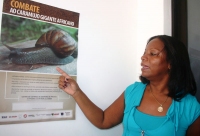

Campaign for the control of giant African snail
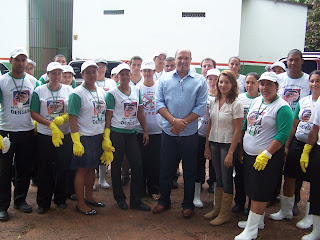


https://www.diarioregion.com/2012/09/10/con-informacion-empieza-el-combate-contra-el-caracol-africano/
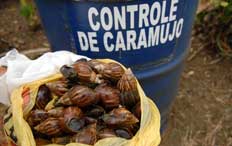
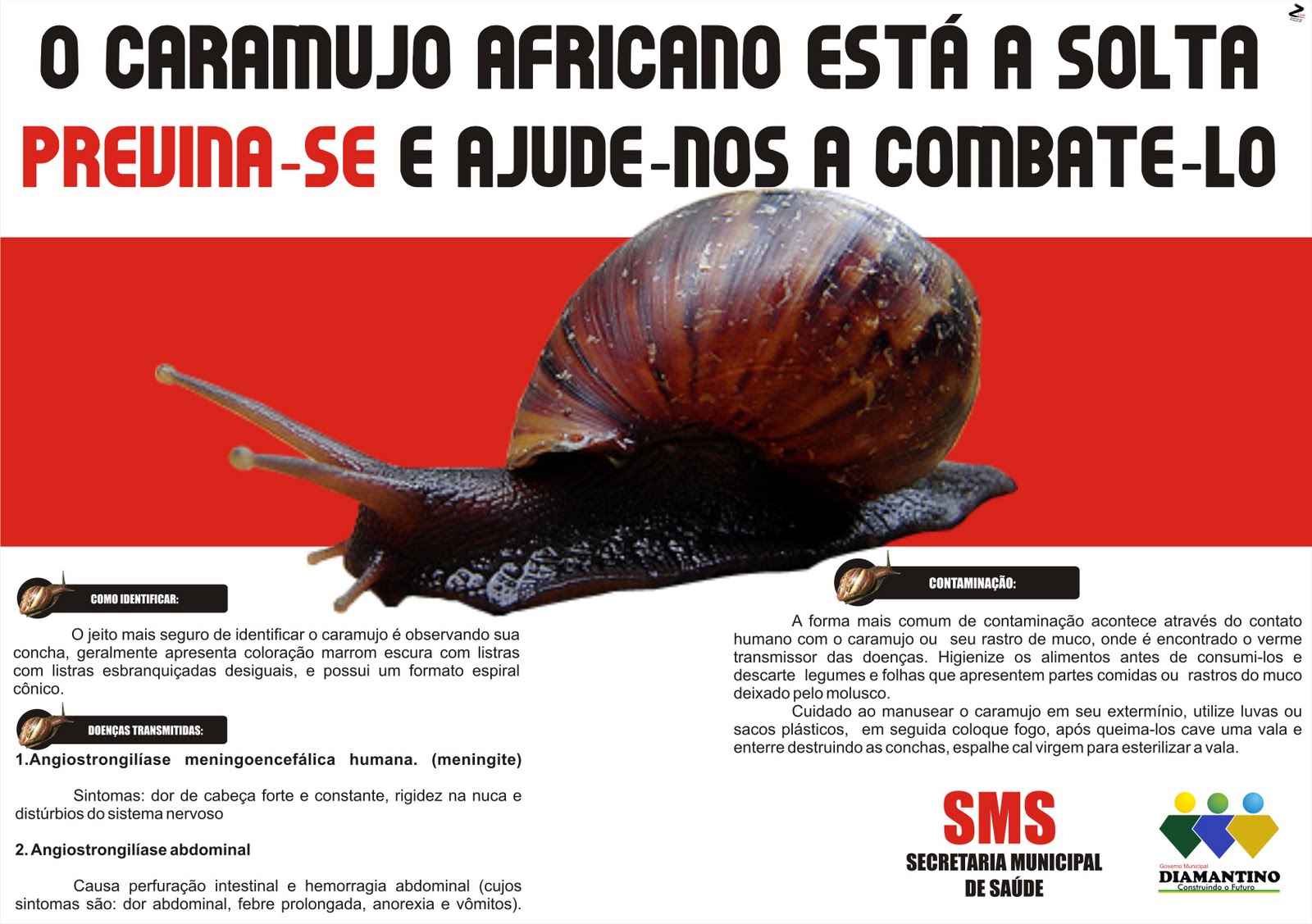



ANALYSIS OF THE CONTEMPLATED SITUATION
Based in the available technical literature (Simone 2006), we have besides the most traditional families of South American giant and medium native and endemic gastropods, included the Families MEGALOBULIMIDAE Leme, 1973 (genus Megalobulimus Miller, 1878) (Agudo-Padrón 2012 - Fig. 5) and STROPHOCHEILIDAE Thiele, 1926 (genus Strophocheilus Spix, 1827, Anthinus Albers, 1850, Mirinaba Morretes, 1952 * (Agudo-Padrón 2012 - Fig. 2) and Speironepion Bequaert, 1948), involving at least 82 forms each, we have some native forest snails of the Family BULIMULIDAE Tryon, 1896, mainly the Subfamily ORTHALICINAE Albers, 1850, currently native species are just more similar, phenotypically, with the invasive exotic African snail (Aquino 2011 a, Agudo-Padrón 2012 - Fig. 4), that same sum in the territory of Brazil and South America a total of approximately 21 forms taxonomically recognized (more why not well known or studied, virtually all of them have surely included in some degree of danger), classified and included in the genera Orthalicus (10 spec.)(Fig. 6), Sultana (2 spec.) and Corona (9 spec.).

* Native florestal snail Mirinaba erythrosoma (Pilsbry, 1895) (STROPHOCHEILIDAE)
Photo: Brazilian Shell Club - CdB

Figure 6.- Rare native florestal snail Orthalicus fischeri Martens, 1893 (BULIMULIDAE)
Photo: Brazilian Shell Club - CdB
Due to their appearance, eventually species of the genus Thaumastus Albers, 1860 (16 spec.) (Fig. 7), florestal snails representatives of the Subfamily BULIMULINAE Tryon, 1867 (Simone 2006, Colley 2012), may become also involved (Coelho 2005).

Figure 7.- Native florestal snail Thaumastus magnificus (Grateloup, 1839) (BULIMULIDAE)
Photo: Brazilian Shell Club - CdB
Until totally different species of native snails BULIMULINAE, Auris bilabiata (Broderip & Sowerby, 1829) (Fig. 8) by example, of rare beauty and scarcely known scientifically are being destroyed in the frenzy created by collective panic (Aquino 2011 b).
Figure 8.- Rare native florestal snail Auris bilabiata (Broderip & Sowerby, 1829) (BULIMULIDAE)
Photo: Brazilian Shell Club - CdB
Even little arboreal native species poorly known are being interchanged (Aquino 2011 d), collected and destroyed without further (Agudo-Padrón 2012 - Fig. 3). This disastrous situation should be occurring, simultaneously, in other locations and countries of the continent (Borrero et al. 2009).

Figure 3.- Little native arboreal snail Drymaeus papyraceus (Mawe, 1823) (BULIMULIDAE)
Upper Photo: Brazilian Shell Club - CdB
The “fatal” potential visual confusion of the invasive African snail with native and endemic species (Agudo-Padrón 2012 - Figs. 4, 5) have been singled out by experts in the literature (Thiengo & Fernandez 2005, Coelho 2005, Colley & Fischer 2009, Pimpão 2010, … among others).
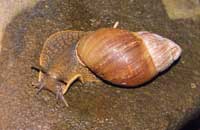
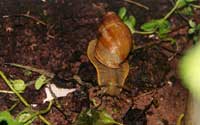
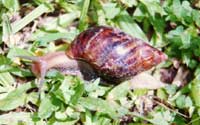
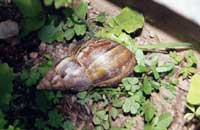
Figure 5.- Native south american snails Megalobulimus cf. elongatus (Bequaert, 1848) (MEGALOBULIMIDAE) and invasive African snails Achatina (Lissachatina) fulica (Bowdich, 1822) … who is who for the laymen ???
(Aquino 2011 f, 2012 a)
Photos: A.I. Agudo-Padrón, Project AM
DISCUSSION AND CONCLUSIONS
The conservation status of native continental molluscs and the parallel occurrence of invasive alien species in the southern region of the country, by example, have been subject to recent extensive discussions and questions (Agudo-Padrón 2009, 2010, 2011 b-g; Agudo-Padrón & Lenhard 2010).
Today, the exotic invasive Achatina (Lissachatina) fulica is present in ALL BRAZILIAN TERRITORY, and the Atlantic Slop of the Southern Cone already settled in the country of Argentina (Gregoric et al. 2011).


Observing the current situation in practice (referential notices and field experience), the public “bad conducted actions” for the control/ eradication of Achatina (Lissachatina) fulica in Brazil (Agudo 2006; Aquino 2011 c, e), officially opened in 2003 with the “prohibition” of the species in the country (Aquino 2012 b) – initially introduced in 1988 through the Paraná State, PR, Southern region (Globo 1992, 1994; Teles & Fontes 2000; Thiengo et al. 2007; Colley & Fischer 2009), and a second time at the beginning of the 1990s, through the “Santos” Port in “Praia Grande”, São Paulo State, SP, Southeastern region (Armellini & Santana s/d) – and consequent “premature release” into the environment of animals in livestock management regime (continental malacoculture or “escargot” farming) for fear of possible law sanctions, today are becoming an important element much more damaging to our suffered native and endemic terrestrial molluscs itself occurrence in wildlife of the giant African invasive snail, unconsciously accelerating the extinction process of the first, by which they urgently need to be re-evaluated and re-oriented by the corresponding authorities.

Campaign for the control of giant African snail


Terrestrial molluscs of Brazil to the path of no return nefarious Trail of Extinction !!!
Moluscos terrestres do Brasil à caminho da nefasta Trilha sem volta da Extinção !!!

Arrival: who will be the first to be extinct?
ACKNOWLEDGEMENTS
Our sincere thanks to MD Veterinarian Maurício Carneiro Aquino, University Federal of Alagoas - UFAL, Maceió, Alagoas, Northeastern Brazil, and the "Brazilian Shell Club" (Conquiliologistas do Brasil – CdB), São Paulo, Southeastern Brazil, for their timely regional informations and photographic material.
REFERENCES:
Agudo(-Padrón), I. 2006. ANGIOSTRONGILÍASE ABDOMINAL. In: Moluscos e saúde pública no Brasil. São Paulo, SP: Conquiliologistas do Brasil - CdB. Available online at: https://www.conchasbrasil.org.br/materias/saude/msaudebra.asp
Agudo-Padrón, A.I. 2009. Endangered continental mollusks of Santa Catarina State, Southern Brazil: an brief overview. FMCS Newsletter Ellipsaria, 11(2): 7-8.
Agudo-Padrón, A.I. 2010. The mollusc fauna of Santa Catarina State, Southern Brasil: knowledge gained from 13 years of research. IUCN/SSC Newsletter Tentacle, 18: 32-37.
Agudo-Padrón, A.I. 2011 a. Evaluative summary of the Santa Catarina's State mollusk fauna, Central Southern Brazil, after 15 years of research. FMCS Newsletter Ellipsaria, 13(4): 37-46. Available online at: https://projetocaramujoafricano.blogspot.com.br/2011/11/felizmente-o-preconceito-ainda-nao.html
Agudo-Padrón, A.I. 2011 b. Exotic molluscs in Santa Catarina’s State, Southern Brazil region (Mollusca, Gastropoda et Bivalvia): check list and regional spatial distribution knowledge. Biodiversity Journal, 2(2): 53-58.
Agudo-Padrón, A.I. 2011 c. Threatened freshwater and terrestrial mollusks of Santa Catarina State, Southern Brazil (Mollusca, Gastropoda et Bivalvia): check list and evaluation of regional threats. Biodiversity Journal, 2(2): 59-66.
Agudo-Padrón, A.I. 2011 d. Mollusc fauna of Santa Catarina State, Central Southern Brasil: current state of knowledge. IUCN/SSC Newsletter Tentacle, 19: 22-24.
Agudo-Padrón, A.I. 2011 e. Mollusca and environmental conservation in Santa Catarina State (SC, Southern Brazil): current situation. Biodiversity Journal, 2(1): 3-8.
Agudo-Padrón, A.I.,2011 f. The continental molluscs of Santa Catarina State, Central Southern Brasil: need for more population studies. IUCN/SSC Newsletter Tentacle, 19: 24-26.
Agudo-Padrón, A.I. 2011 g. Current knowledge on population studies on five continental molluscs (Mollusca, Gastropoda et Bivalvia) of Santa Catarina State (SC, Central Southern Brazil region). Biodiversity Journal, 2(1): 9-12.
Agudo-Padrón, A.I. 2012. Conservation situation of native land snails threatened by “actions for eradication” of exotic species in Brazil, South America. Biological Evidence, 2(1): 1-2. Available online at: https://bio.sophiapublisher.com/html-464-40-be
Agudo-Padrón, A.I. & Lenhard, P. 2010. Introduced and invasive exotic molluscs in Brazil: an brief overview. IUCN/SSC Newsletter Tentacle, 18: 37-41.
Aquino, M.C. 2011 a. E agora IBAMA ?. Informativo AchatinafulicaNEWS, 9: 8-11. Available online at: https://projetocaramujoafricano.blogspot.com.br/2011/08/e-agora-ibama.html
Aquino, M.C. 2011 b. A Imprensa: o maior inimigo da malacofauna mundial. Maceió, AL: Projeto Caracol Africano, 07/10/2011. Available online at: https://projetocaramujoafricano.blogspot.com.br/2011/10/imprensa-o-maior-inimigo-da-malacofauna.html
Aquino, M.C. 2011 c. O terror feito com o "Achatina fulica". Maceió, AL: Projeto Caracol Africano, 11/11/2011. Available online at: https://projetocaramujoafricano.blogspot.com.br/2011/11/o-terror-feito-com-o-achatina-fulica.html
Aquino, M.C. 2011 d. Mais um flagrante de ignorância e preconceito. Maceió, AL: Projeto Caracol Africano, 29/10/2011. Available online at: https://projetocaramujoafricano.blogspot.com.br/2011/10/mais-um-fragrante-de-ignorancia-e.html
Aquino, M.C. 2011 e. Urgente: o risco da internet !!!. Maceió, AL: Projeto Caracol Africano, 16/10/2011. Available online at: https://projetocaramujoafricano.blogspot.com.br/2011/10/urgente.html
Aquino, M.C. 2011 f. Participe da pesquisa do PDPM ... . Maceió, AL: Projeto Caracol Africano, 01/10/2011. Available online at: https://projetocaramujoafricano.blogspot.com.br/2011/10/participe-da-pesquisa-do-pdpm-do.html
Aquino, M.C. 2012 a. Absurdo: um site ecológico ... . Maceió, AL: Projeto Caracol Africano, 17/03/2012. Available online at: https://projetocaramujoafricano.blogspot.com.br/2012/03/mais-um-absurdo-um-site-ecologico.html
Aquino, M.C. 2012 b. As orígens da silenciosa crise malacológica brasileira. Maceió, AL: Projeto Caracol Africano, 06/01/2012. Available online at: https://projetocaramujoafricano.blogspot.com.br/2012/01/as-origens-da-silenciosa-crise.html
Armellini, F.A.B. de & Santana, E. s/d. Prazer na mesa e lucro no bolso - sua excelência o Escargot. Helicicultura Kapiatan, São Paulo, 144 pp.
Borrero, F.J.; Breure, A.S.H.; Christensen M.C. & Avila, V.M. 2009. Into the Andes: three new introductions of Lissachatina fulica (Gastropoda, Achatinidae) and its potential distribution in South America. IUCN/SSC Newsletter Tentacle, 17: 6-8.
Coelho, L.M. 2005. Informe técnico para o controle do caramujo africano (Achatina fulica, Bowdch 1822 em Goiás. AGENCIARURAL, Goiânia, 12 pp.
Colley, E. 2012. Nova espécie de Thaumastus da Floresta Atlântica do Paraná, Brasil (Mollusca, Gastropoda, Pulmonata, Bulimuloidea). Iheringia, Sér. Zoologia, Porto Alegre, 102(1): 43-47.
Colley, E. & Fischer, M.L. 2009. Avaliação dos problemas enfrentados no manejo do caramujo gigante africano Achatina fulica (Gastropoda: Pulmonata) no Brasil. Zoologia, 26(4): 674-683.
Globo Ed., 1992. Escargot - Caracol Tropical. Revista "Globo Rural", 7(75): 31-32.
Globo Ed., 1994. Escargot - mais que um simples caracol. Revista "Globo Rural", 10(101 – Especial): 24-34.
Gregoric, D.E.G.; Núñez, V.; Vogler, R. & Rumi, A. 2011. Invasion of the argentinean paranense rainforest by the gian african snail Achatina fulica. American Malacological Bulletim, 29(1-2): 135-137.
Pimpão, D.M. 2010. Caramujo-africano no Amazonas: "Megalobulimus fulica" ou "Pomacea fulica"?. Informativo SBMa, Rio de Janeiro, 41(172): 13-14. Available online at: https://sbmalacologia.com.br/wp-content/uploads/2011/08/Informativo-41-172-30_06_10.pdf
Simone, L.R.L. 2006. Land and freshwater molluscs of Brazil. FAPESP, São Paulo, 390 pp.
Teles, H.M.S. & Fontes, L.R. 2000. Implicações da introdução e dispersão de Achatina fulica Bowdich, 1822 no Brasil. Boletim do Instituto Adolfo Lutz, 12(1): 3-5.
Thiengo, S.C.; Faraco, F.A.; Salgado, N.C.; Cowie, R.H. & Fernandez, M.A. 2007. Rapid spread of an invasive snail in South America: the giant African snail, Achatina fulica, in Brazil. Biological Invasions, 9(6): 693-702.
Thiengo, S. C. & Fernández, M. A. 2005. Achatina fulica in Brasil: the current situation. IUCN/SSC Newsletter Tentacle, 13: 7.
https://noticias-malacologicas-am.webnode.pt/news/preocupante-historico-vigente-dossier-de-flagrantes-crise-malacologica-/
https://www.smtpilimitado.com/kennel/caracol10.pdf

